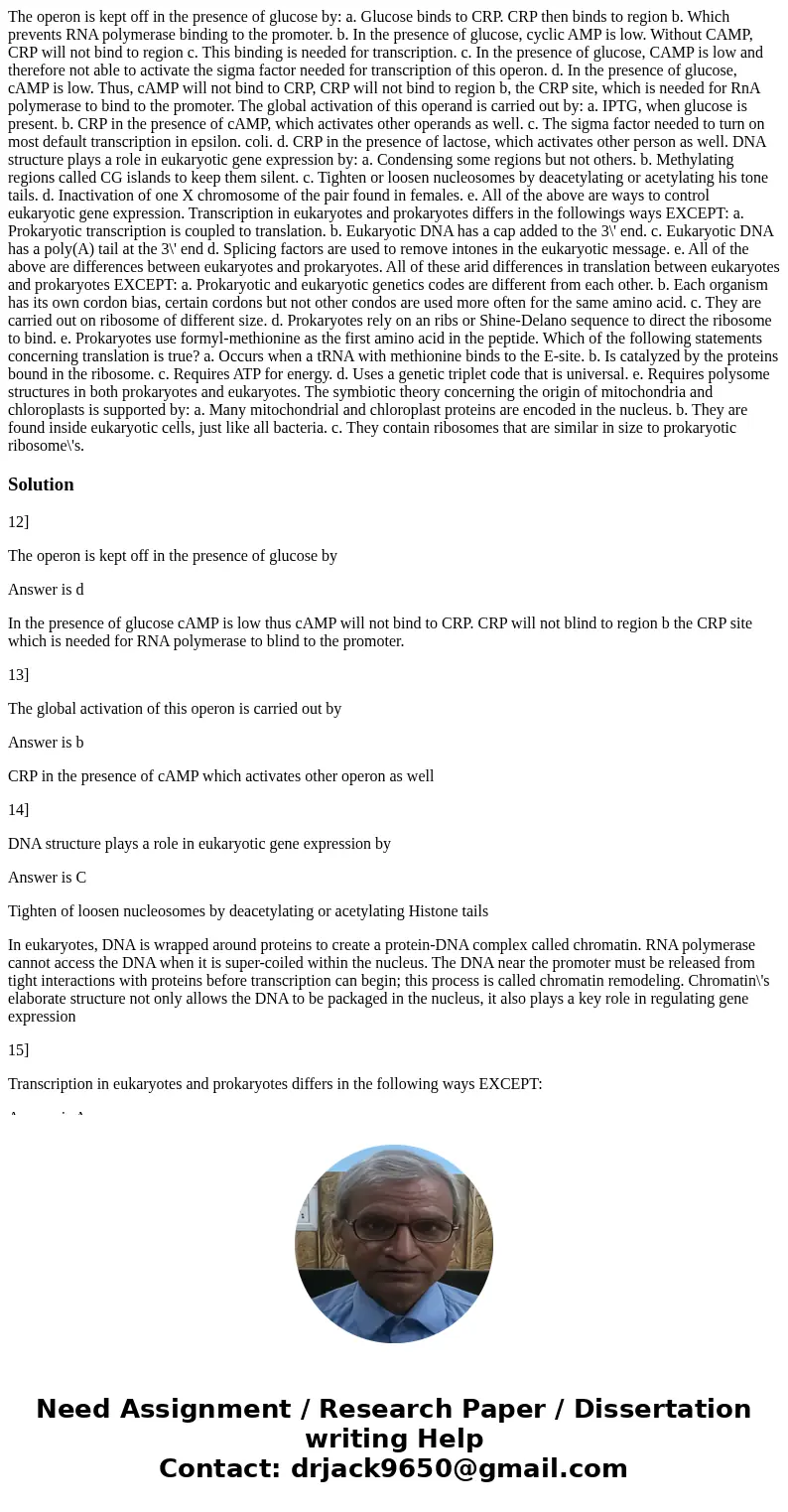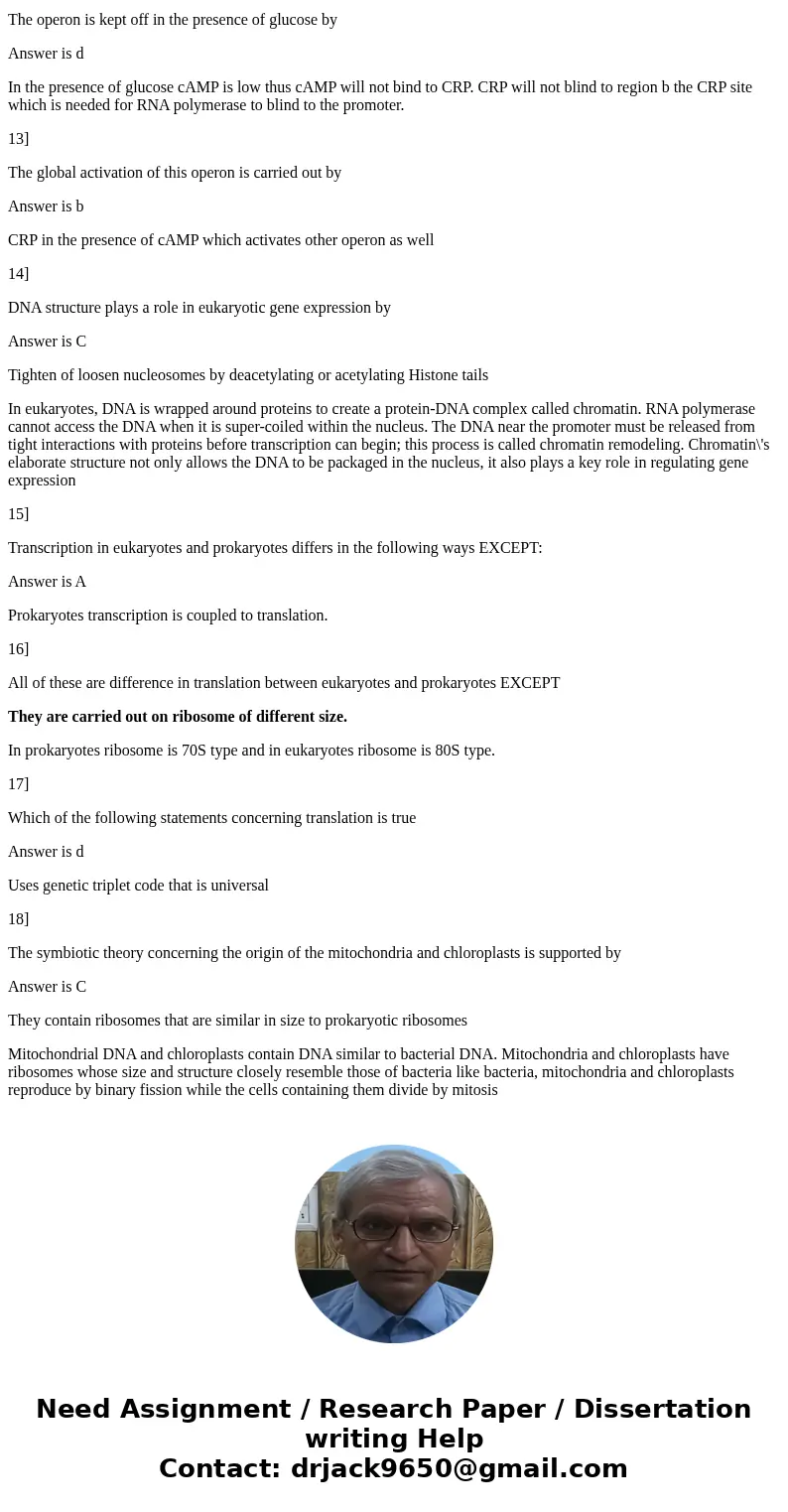The operon is kept off in the presence of glucose by: a. Glucose binds to CRP. CRP then binds to region b. Which prevents RNA polymerase binding to the promoter. b. In the presence of glucose, cyclic AMP is low. Without CAMP, CRP will not bind to region c. This binding is needed for transcription. c. In the presence of glucose, CAMP is low and therefore not able to activate the sigma factor needed for transcription of this operon. d. In the presence of glucose, cAMP is low. Thus, cAMP will not bind to CRP, CRP will not bind to region b, the CRP site, which is needed for RnA polymerase to bind to the promoter. The global activation of this operand is carried out by: a. IPTG, when glucose is present. b. CRP in the presence of cAMP, which activates other operands as well. c. The sigma factor needed to turn on most default transcription in epsilon. coli. d. CRP in the presence of lactose, which activates other person as well. DNA structure plays a role in eukaryotic gene expression by: a. Condensing some regions but not others. b. Methylating regions called CG islands to keep them silent. c. Tighten or loosen nucleosomes by deacetylating or acetylating his tone tails. d. Inactivation of one X chromosome of the pair found in females. e. All of the above are ways to control eukaryotic gene expression. Transcription in eukaryotes and prokaryotes differs in the followings ways EXCEPT: a. Prokaryotic transcription is coupled to translation. b. Eukaryotic DNA has a cap added to the 3\' end. c. Eukaryotic DNA has a poly(A) tail at the 3\' end d. Splicing factors are used to remove intones in the eukaryotic message. e. All of the above are differences between eukaryotes and prokaryotes. All of these arid differences in translation between eukaryotes and prokaryotes EXCEPT: a. Prokaryotic and eukaryotic genetics codes are different from each other. b. Each organism has its own cordon bias, certain cordons but not other condos are used more often for the same amino acid. c. They are carried out on ribosome of different size. d. Prokaryotes rely on an ribs or Shine-Delano sequence to direct the ribosome to bind. e. Prokaryotes use formyl-methionine as the first amino acid in the peptide. Which of the following statements concerning translation is true? a. Occurs when a tRNA with methionine binds to the E-site. b. Is catalyzed by the proteins bound in the ribosome. c. Requires ATP for energy. d. Uses a genetic triplet code that is universal. e. Requires polysome structures in both prokaryotes and eukaryotes. The symbiotic theory concerning the origin of mitochondria and chloroplasts is supported by: a. Many mitochondrial and chloroplast proteins are encoded in the nucleus. b. They are found inside eukaryotic cells, just like all bacteria. c. They contain ribosomes that are similar in size to prokaryotic ribosome\'s.
12]
The operon is kept off in the presence of glucose by
Answer is d
In the presence of glucose cAMP is low thus cAMP will not bind to CRP. CRP will not blind to region b the CRP site which is needed for RNA polymerase to blind to the promoter.
13]
The global activation of this operon is carried out by
Answer is b
CRP in the presence of cAMP which activates other operon as well
14]
DNA structure plays a role in eukaryotic gene expression by
Answer is C
Tighten of loosen nucleosomes by deacetylating or acetylating Histone tails
In eukaryotes, DNA is wrapped around proteins to create a protein-DNA complex called chromatin. RNA polymerase cannot access the DNA when it is super-coiled within the nucleus. The DNA near the promoter must be released from tight interactions with proteins before transcription can begin; this process is called chromatin remodeling. Chromatin\'s elaborate structure not only allows the DNA to be packaged in the nucleus, it also plays a key role in regulating gene expression
15]
Transcription in eukaryotes and prokaryotes differs in the following ways EXCEPT:
Answer is A
Prokaryotes transcription is coupled to translation.
16]
All of these are difference in translation between eukaryotes and prokaryotes EXCEPT
They are carried out on ribosome of different size.
In prokaryotes ribosome is 70S type and in eukaryotes ribosome is 80S type.
17]
Which of the following statements concerning translation is true
Answer is d
Uses genetic triplet code that is universal
18]
The symbiotic theory concerning the origin of the mitochondria and chloroplasts is supported by
Answer is C
They contain ribosomes that are similar in size to prokaryotic ribosomes
Mitochondrial DNA and chloroplasts contain DNA similar to bacterial DNA. Mitochondria and chloroplasts have ribosomes whose size and structure closely resemble those of bacteria like bacteria, mitochondria and chloroplasts reproduce by binary fission while the cells containing them divide by mitosis


 Homework Sourse
Homework Sourse